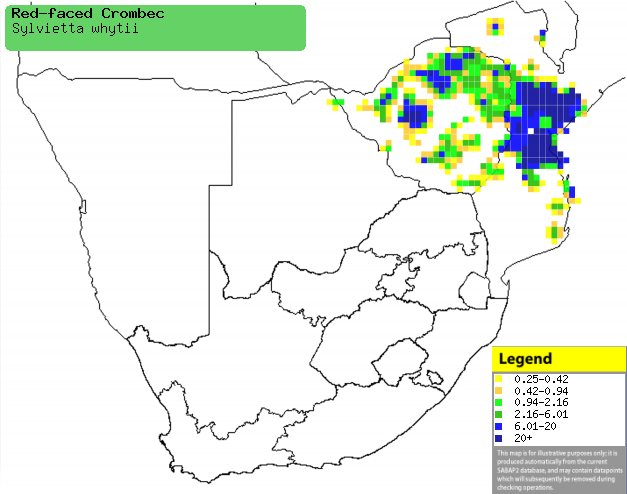|
Sylvietta whytii (Red-faced
crombec)
Rooiwangstompstert [Afrikaans]; Roodteugelkrombek [Dutch];
Crombec à face rousse [French]; Whytes sylvietta [German];
Rabicurta-de-faces-vermelhas [Portuguese]
Life
> Eukaryotes >
Opisthokonta
> Metazoa (animals) >
Bilateria >
Deuterostomia > Chordata >
Craniata > Vertebrata (vertebrates) > Gnathostomata (jawed
vertebrates) > Teleostomi (teleost fish) > Osteichthyes (bony fish) > Class:
Sarcopterygii (lobe-finned
fish) > Stegocephalia (terrestrial
vertebrates) > Tetrapoda
(four-legged vertebrates) > Reptiliomorpha > Amniota >
Reptilia (reptiles) >
Romeriida > Diapsida > Archosauromorpha > Archosauria >
Dinosauria
(dinosaurs) > Saurischia > Theropoda (bipedal predatory dinosaurs) >
Coelurosauria > Maniraptora > Aves
(birds) >
Order: Passeriformes > Family: Sylviidae
> Genus: Sylvietta
Distribution and habitat
Occurs across the southern half of the DRC through Angola
and Zambia to southern Africa. Here it is fairly common across Zimbabwe and
central Mozambique, preferring Miombo (Brachystegia) and Zambezi teak (Baikiaea
plurijuga) woodland, as well as the edges of evergreen forest.
|
 |
|
Distribution of Red-faced crombec in southern Africa,
based on statistical smoothing of the records from first SA Bird Atlas
Project (©
Animal Demography unit, University of
Cape Town; smoothing by Birgit Erni and Francesca Little). Colours range
from dark blue (most common) through to yellow (least common). |
Food
It mainly feeds on invertebrates, plucking them from twigs
& branches. It is also a common member of mixed-species foraging flocks. The following food items have been recorded
in its diet:
Breeding
- The nest is a hanging pouch built of fine bark strips, dead leaves,
lichen, seed pods and flowers, bound together with spider web. It is
typically suspended between a forked twig on the edge of a bare tree.
- Egg-laying season in Zimbabwe is from August-December, peaking around
September-November.
- It lays 1-3 eggs, which are incubated mainly by the female for roughly
13-14 days (recorded in captivity). The chicks are fed by both adults,
leaving the nest after about 14-17 days.
Threats
Not threatened.
References
-
Hockey PAR, Dean WRJ and Ryan PG 2005. Roberts
- Birds of southern Africa, VIIth ed. The Trustees of the John Voelcker
Bird Book Fund, Cape Town.
|
